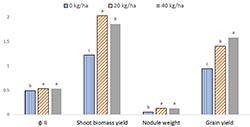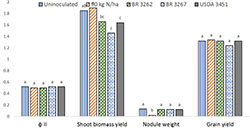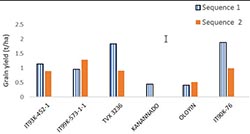The trials conducted in 2016 were repeated in 2017 to determine the effects of phosphorus fertilizer application and rhizobial inoculation on photosynthetic efficiency, nodulation, growth and productivity of three cowpea varieties and secondly to evaluate the performance of some varieties of cowpea in cowpea-cowpea sequential cropping system on three farmers’ fields in Minna, southern Guinea savanna of Nigeria.
The treatments of the first trial included three phosphorus rates (0, 20 and 40 kg P ha-1), five nitrogen sources (uninoculated, application of 90 kg N ha-1, inoculation with BR 3262, BR 3267 and USDA 3451 rhizobial strain) and three cowpea varieties (IT99K-573-1-1, IT93K-452-1 and TVX 3236). These were factorially combined and laid out in a randomized complete block design. The treatments of the second trial included six varieties of cowpea viz: IT93K-452-1, IT90K-76, Oloyin, IT99K-573-1-1, TVX-3236 and Kanannado planted in two sequence.
The results revealed that:
|

|
|
|

|
|

|
The result of the second trial revealed that:
|

|
|
Conclusion
- P application is important for optimum performance of cowpea in the study area.
- The symbiotic effectiveness of the rhizobial inoculants used was not better than the indigenous strain present in the study area.
- IT99K-573-1-1 performed relatively better in grain yield than the other two varieties used.
- TVX 3236 and IT90K-76 are the best cowpea varieties among those tested for early planting in the study area.
- IT90K-76, TVX 3236, IT99K-573-1-1 and IT93K-452-1 can be recommended for cultivation in cowpea-cowpea sequential cropping system in the study area.
Adediran Olaotan Abimbola, Federal University of Technology, Minna, Nigeria (Click here for her 2017 update)
